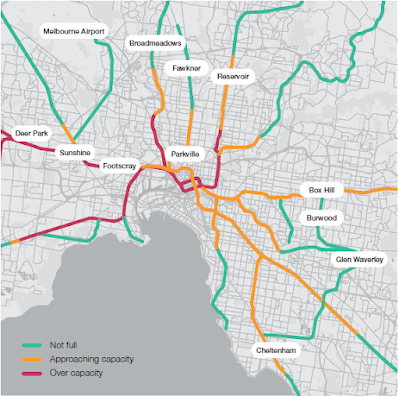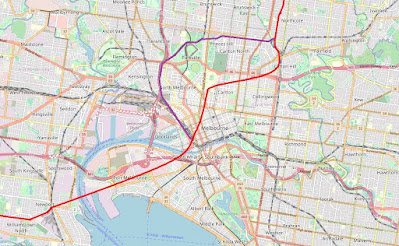 |
| Diagram of proposed MM2 amongst Melbourne's network (via IV) |
Recommendation 61 of Infrastructure Victoria's 30-year strategy is to "Prepare for Melbourne Metro Two and direct Geelong rail services". They're more positive about the project than last time, and it seems the potential for Geelong services to use it has been one of the key things to influence this. But they're less keen on the northern part of the project, recommending it be built in two stages and that the route from Southern Cross to Clifton Hill be reconsidered. Let's take a closer look at this.
Firstly, some background. For those who haven't come across it, MM2 is the proposed successor to the Melbourne Metro 1 tunnel the government is currently building. Just as MM1 will link the existing Cranbourne/Dandenong and Sunbury lines on opposite sides of the city, adding capacity and taking pressure off the City Loop, MM2 would do basically the same thing for the Werribee and Mernda lines. As currently conceived, it would be built as one long bored tunnel, much the same as MM1 has been built.
This would free up space between Newport, Footscray and the city for Altona and Williamstown trains, and free up space from Clifton Hill through the City Loop for Hurstbridge trains - so not only would the lines that would plug into MM2 get to run more frequently, but the lines they used to share tracks with also get to run more frequently.
The other big advantages of MM2 are added coverage, and improved directness. New stations would be built in Fishermans Bend and likely somewhere in the Fitzroy/Carlton area, where no stations currently exist, adding coverage. Trains from Werribee (and potentially future electrified trains from Geelong) would also get a quicker and more direct path from Newport to the city, compared with the fairly long and circuitous path via Footscray they take today.
 |
| The Werribee and Clifton Hill lines will be over capacity by 2036 (via IV) |
When it comes to the Newport-Southern Cross section, IV are very much on board with this vision. The modelling used by IV recognises that the Werribee line via Footscray, and the inner sections of the Mernda and Hurstbridge lines, will be over capacity by 2036 if nothing is done, and they recognise that Fishermans Bend will be such a big and dense development that a tram alone won't cope without heavy rail to support it. The potential to use it for Geelong services seems to have sealed the deal for them - it'd provide a nice clean run into Southern Cross for them, both in terms of being straighter and quicker but also less congested (one of the big issues approaching Southern Cross from the north).
When it comes to the Southern Cross-Clifton Hill section, though, they're clearly much less keen. They note the Fitzroy/Carlton area is already very well-served by trams, so the uplift in PT access is proportionally less than in a PT desert like Fishermans Bend. So they want to cut costs in order to get better value for money, and suggest "an alternative alignment may be a more direct and less costly option, such as along the former Inner Circle railway line".
 |
| The Inner Circle (purple) would be less direct than a tunnel (via OpenStreetMap) |
This is so ridiculous I had to re-read it several times to make sure I hadn't misunderstood. The first problem is that any alignment that used the Inner Circle would be significantly less direct. If the point of using the Inner Circle is to avoid/minimise tunnelling then presumably the idea would be to use the existing Upfield line tracks between Southern Cross and Royal Park, like the original Inner Circle - which is way less direct than a tunnel.
The second problem is, it's probably not feasible because those Upfield line tracks will also be very congested (which is one of the things their Recommendation 60 is designed to address). And if they're not intending to use the Upfield line, it would take substantial tunnelling to get from the CBD up to the Inner Circle - basically as much as just tunnelling directly to Clifton Hill would.
The third problem is that this makes a connection with the Hurstbridge line at Clifton Hill station basically impossible. Even with a tunnel approaching from the south this is a substantial challenge - and the long-term desire to straighten out the notorious Rushall curves contributes to this - but if you're coming along the Inner Circle, how can you possibly connect at Clifton Hill and also head north to Merri? Maybe they don't plan to connect with Clifton Hill - but then why do all their diagrams show a connection?
Like I said - completely ridiculous. How a thought-bubble like this got through the drafting process of a major government body I will never know.
 |
| A full tunnel is pretty clearly the best option (via IV) |
The other thing I think is worth mentioning is that trying to find a non-bored solution to the northern section, and splitting the project into two phases, are symptoms of Infrastructure Victoria being run by economists rather than infrastructure experts. The demand projects their modelling is based on does indicate that the southern section is required slightly earlier than the northern section, and to an economist this says "Well it'll be maximally efficient if we split it in two, then!" But to a project manager, splitting it in two means you lose a ton of efficiency in winding one phase down and winding the other up - way more efficiency than you'd ever gain from delaying the second half.
This is particularly true if they're looking for a non-bored method of constructing the northern section - yes, bored tunnels can be more expensive than other construction methods, but bored tunnels also benefit massively from economies of scale. Long tunnels tend to cost less per-km than short ones - if we procure a TBM and get it to bore from Newport to Southern Cross, stopping and changing to a different construction method for the second half isn't likely to be cheaper than just continuing the TBM to Clifton Hill. Especially if it literally just does keep going straight away, rather than pausing for a few years between phases.
As with Melton electrification, though, I'm pretty confident the people in the DOT will recognise this and word the government up. Remember that MM1 was also originally proposed to be built in two phases, and the government ultimately decided to just do it all in one go for efficiency reasons - I'd be pretty surprised if the same didn't happen here. In any case, let's hope they do follow the recommendation and commit to funding a business case ASAP, so we can sort through these questions and get cracking.
More discussion on IV's 30-year strategy here
One advantage to a two stage MM2 is it forces the first half (at Southern Cross) to be a terminating station for dedicated electrified high speed geelong rolling stock (rolling MM2 into Geelong Fast Rail). The lines may be at capacity, but so is Southern Cross' platform capacity for regional services, especially during peak hour. Eventually, it is likely we will need a second regional terminal in the CBD, and it does make sense to build a second Southern Cross terminal - perhaps underground? Planning a little too far forward, it would be a good staging ground for future high speed rail departures: HSR to Adelaide via Geelong? HSR to Sydney via a northern exit? It does free up Southern Cross platform capacity for other services in the meantime.
ReplyDeleteOtherwise, if we built the whole of MM2 in one go, the southern cross bit would likely be a strange through station, and the Geelong and Mernda lines would be merged into one. Geelong's new (probably $$) rolling stock would be under utilised as it would spend more than half its route length acting as conventional metropolitan service. Better to have a new terminal at Southern Cross for Geelong Fast Rail through MM2, and separately have Werribee (or Wyndham Vale via Werribee) services through to Mernda via the same tracks (or 4 track cluster).
See, I'd take the alternative viewpoint here: to me, MM2 is an enabler for Waurn Ponds electrification. You'd want to pair it with a few other projects to deal with speeds, of course, but just getting a 160km/h electrified express via Werribee and MM2 would still get Geelong to Southern Cross down quite a bit.
DeleteMy thoughts are this:
- Quad Laverton to Werribee (or maybe even to North Shore), and electrify to Waurn Ponds, as well as Deer Park via RRL
- Altona Loop trains pick up the stops between Werribee and Laverton, then go up the RRL. A branch could also go to North Shore, removing Little River and Corio from the Geelong Line
- Just run the normal rolling stock into MM2
If you can pull 160km/h from North Shore to Newport, even with those intermediary stops you'd cover that bit in around 32 minutes (provided I haven't goofed my maths). Add 7 minutes for Geelong to North Shore, 6 minutes to SC via MM2, and that's 45 minutes, no new rolling stock needed.
(I ran the above numbers using the acceleration and braking of a X'Trapolis, btw, so this is doable with existing rolling stock)
Even if you got something that could do 200km/h or higher, though, I don't think it would be a waste to send it to Mernda. We aren't wasting the existing trains because nowhere on the network can support 160km/h running, are we?
The original two stage Metro Tunnel was much larger in scope - stage one terminated at Domain Interchange, the second stage continued further down St Kilda Road until it eventually reached Caulfield station, serving up to three additional station on the way.
ReplyDeletehttps://raildocs.wongm.com/melbourne-metro-rail-tunnel/Figure+4-5+MM2+alignment+options+between+Domain+and+Caulfield.jpg.html
Was going to point out what Marcus has already done, one of the reasons why a South Yarra station was never costed as part of the Metro tunnel was that the original plan never had it going anywhere near South Yarra.
ReplyDeleteLuckily for us, if they ever do want to build Stage 2, it's fairly easy to build off the current tunnels. The London Tube has done this numerous times, as extentions to lines have taken a different path (most recently the Northern Line at Kennington, but also the Jubilee at Charring Cross as well as others).
Long term when looking for a cheap way to build a 3rd track pair between South Yarra and Dandenong, extending Metro 1 via Balaclava to Caulfield is very straight forward.
To add to my comment above, Sydney Metro built a spur line off an existing tunnel at Epping.
Delete